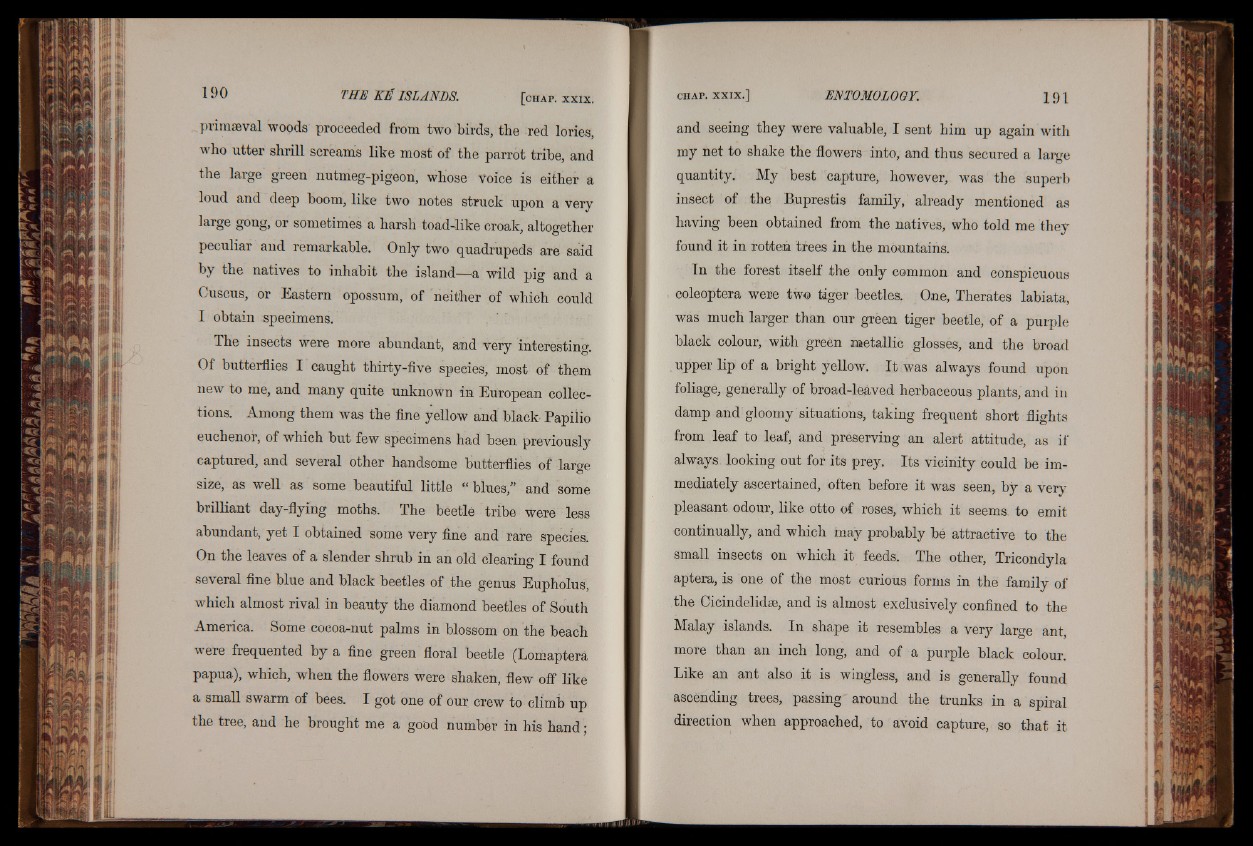
primaeval woods proceeded from two birds, the red lories,
who utter shrill screams like most of the parrot tribe, and
the large green nutmeg-pigeon, whose voice is either a
loud and deep boom, like two notes struck upon a very
large gong, or sometimes a harsh toad-like croak, altogether
peculiar and remarkable. Only two quadrupeds are said
by the natives to inhabit the island—a wild pig and a
Cuscus, or Eastern opossum, of neither of which could
I obtain specimens.
The insects were more abundant, and very interesting.
Of butterflies I caught thirty-five species, most of them
new to me, and many quite unknown in European collections.
Among them was the fine yellow and black- Papiiio
euchenor, of which but few specimens had been previously
captured, and several other handsome butterflies of laro-e
size, as well as some beautiful little “ blues,” and some
brilliant day-flying moths. The beetle tribe were less
abundant, yet I obtained some very fine and rare species.
On the leaves of a slender shrub in an old clearing I found
several fine blue and black beetles of the genus Eupholus,
which almost rival in beauty the diamond beetles of South
America. Some cocoa-nut palms in blossom on the beach
were frequented by a fine green floral beetle (Lomaptera
papua), which, when the flowers were shaken, flew off like
a small swarm of bees. I got one of our crew to climb up
the tree, and he brought me a good number in his hand;
and seeing they were valuable, I sent him up again with
my net to shake the flowers into, and thus secured a large
quantity. My best capture, however, was the superb
insect of the Buprestis family, already mentioned as
having been obtained from the natives, who told me they
found it in rotten trees in the mountains.
In the forest itself the only common and conspicuous
coleóptera were two tiger beetles. One, Therates labiata,
was much larger than our green tiger beetle, of a purple
black colour, with green metallic glosses, and the broad
upper lip of a bright yellow. It was always found upon
foliage, generally of broad-leaved herbaceous plants, and in
damp and gloomy situations, taking frequent short flights
from leaf to leaf, and preserving an alert attitude, as if
always, looking out for its prey. Its vicinity could be immediately
ascertained, often before it was seen, by a very
pleasant odour, like otto of roses, which it seems, to emit
continually, and which may probably be attractive to the
small insects on which it feeds. The other, Tricondyla
aptera, is one of the most curious forms in the family of
the Cicindelidse, and is almost exclusively confined to the
Malay islands. In shape it resembles a very lar^e ant,
more than an inch long, and of a purple black colour.
Like an ant also it is wingless, and is generally found
ascending trees, passing around the trunks in a spiral
direction when approached, to avoid capture, so that it